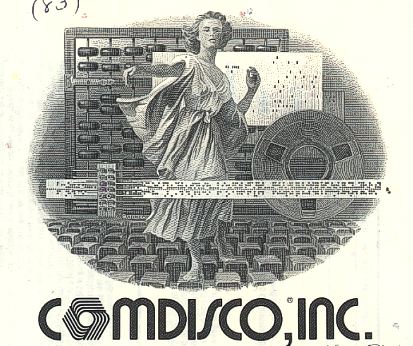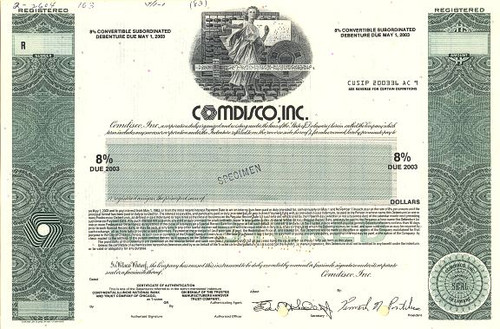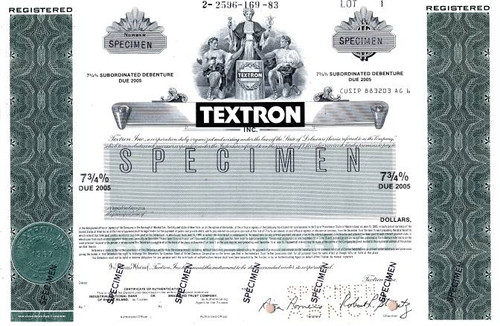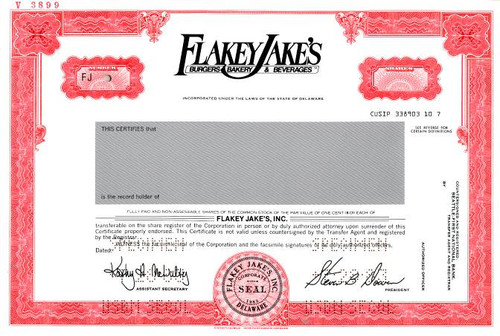Beautiful engraved specimen certificate from the Comdisco, Inc. dated in 1983. This historic document was printed by American Bank Note Company and has an ornate border around it with a vignette of an allegorical woman. This item has the printed signatures of the Company's President and Secretary and is over 33 years old. 
Certificate Vignette In 1969, Kenneth Pontikes, a 29-year-old former salesman for IBM, borrowed $5,000 from his father to start a computer leasing business he named the Computer Discount Corp. In 1971, when Pontikes began to sell stock to the public, the name was changed to Comdisco. By the late 1970s, the company began to open offices overseas, and annual revenues topped $100 million. In the early 1990s, when revenues hit $2 billion, Comdisco ranked as the nation's leading computer equipment leasing company. By the end of the 1990s, the company, based in suburban Rosemont, was doing annual sales of $4 billion and employed nearly 1,500 people in the Chicago area. Comdisco expanded in the Internet boom, then collapsed, filing first for bankruptcy in July 2001 and then beginning liquidation in July 2002. -------------------------------------------------------------------------------- Comdisco was one of the most impressive entrepreneurial success stories of the 1970s and 1980s; it has grown from a one-man operation into one of the world's largest companies for selling and leasing used computers. With its disaster recovery services for computer users and its foray into the field of supplying high-technology medical equipment, the company is preparing for the computer needs of the 21st century. The founder of Comdisco, Ken Pontikes, a first-generation American of Greek ancestry, began working before the age of 11 in his father's grocery store on the south side of Chicago. While a teenager, he worked as a redcap at Union Station, hauling luggage to save for tuition at Southern Illinois University. After graduation, he worked for IBM selling punch card equipment. Working for IBM during the mid-1960s, Pontikes noticed a new and highly promising market beginning to emerge. Large corporations were becoming increasingly reliant on computers and computer technology, but most of these firms hesitated to spend the large amounts of money needed to buy equipment that might become obsolete overnight. In order to meet this growing demand, in 1969 Pontikes started the Computer Discount Corporation. With a capitalization of $5,000, the company opened as a broker/dealer of IBM mainframe computers and soon afterward began leasing the same equipment. Pontikes was enormously successful--one year later the company's revenues amounted to approximately $1 million, and he had hired two employees. The owner believed that he was providing a valuable service, that this service was cost-effective, and that he had a solid customer base upon which he could rely. As the demand for using computers on a short-term basis grew, the newly renamed Comdisco's revenues began to soar. By 1973 the company reported over $24 million in revenues. During its early years, Comdisco held an enviable strategic position within the highly competitive computer market. When IBM announced a new line of computers, most companies in the computer business suffered due to head-on competition with the dominant firm in the marketplace, but Comdisco actually benefited from IBM's technological advancements. Immediately after IBM's announcement, a sales freeze would occur as users delayed the decision to buy while they waited for the new equipment. As a consequence, the prices on computers dropped sharply. At this point, Pontikes started buying inventory and preparing for the inevitable scenario: IBM's delivery schedule stretched out over a number of years, and users would likely be scrambling for the computer equipment they needed for the interim. Comdisco's success entailed some risks, however. In 1974 the company suffered its only loss to date when Intel Corporation dumped $250 million worth of IBM System 360 computers into the resale market only a few months after Pontikes struck a deal to purchase hundreds of System 360 computers. The loss amounted to a bit less than $1 million and taught Pontikes a lesson about the volatility of the market. After that time, he kept Comdisco's inventory at less than two months' sales&mdash〉proximately $20 million worth of computer equipment. Leasing companies sometimes run risks when they offer their customers lenient lease terms and at the same time overestimate the residual value of the equipment--the value and selling price of the computer after the lease has expired. If the leasing company is unable to sell the equipment for its residual value as stated in the company's books, then it suffers a loss on the leasing transaction. Computer leasing is particularly risky because equipment values are at the mercy of lightning-quick changes in technology. For two decades after the loss in 1974, Comdisco only changed its residual estimates three times. Every one of those occasions required an increase in residual estimates. In 1975 Comdisco's earnings rebounded, and revenues surpassed $47 million. One year later, Comdisco Financial Services, Inc., was established to finance its customers' leasing of IBM computer equipment and other non-computer goods. Comdisco Financial Services not only arranged financing for a new IBM computer but also assisted customers in disposing of their old equipment. By offering such services, the subsidiary grew rapidly. With business booming due to the success of its leasing and resale activities, soon Comdisco sales offices were opened in Texas, Minnesota, California, Massachusetts, Connecticut, Florida, and Michigan; overseas branches were opened in France, Switzerland, and West Germany. By the end of the decade, Comdisco employed 186 people and revenues had reached the $225 million mark. Developing new ventures that augmented Comdisco's main computer leasing business, Pontikes created Comdisco Disaster Recovery Services in 1980. Pontikes intended to open numerous disaster relief centers around the country to aid subscribers with computer and office equipment when their own machines were out of service due to flood or fire damage, loss of power, or some other catastrophe. Along with the disaster relief services, customers had the option of leasing "shells"&mdash--pty rooms with controlled temperatures and numerous wall sockets so they could use Comdisco's inventory to recreate their own computer and office machine configurations. Over a few years, Comdisco opened DRS offices in Chicago, the Dallas-Ft. Worth area, northern California, and a "super center" in Carlstadt, New Jersey. With revenues over $500 million and earnings more than $51 million in 1983, Pontikes decided to use some of the excess cash to enter the arbitrage business. In 1984 he established Comdisco Equities, Inc., a subsidiary engaged in high-risk stock speculation of possible takeover targets, and hired Martin A. Weinstein of Salomon Brothers to direct the operation. The owner was convinced that the complicated computer deals his company had put together in the recent past had prepared the way for entering the world of fast-paced, highly speculative arbitrage. In the same year, Comdisco's leasing activities hit an all-time high, and new international sales offices were opened in both the United Kingdom and the Netherlands. The Internal Revenue Service and the Securities and Exchange Commission began investigating Comdisco's tax shelters. The company used shelters to raise money toward the purchase of computer equipment. When Comdisco bought a computer from IBM, they leased it to a customer. The company then took the lease to a bank and collected the present value of the lease payment, which was approximately 90 percent of the computer's original cost. The customer paid back this nonrecourse loan, and the transaction greatly reduced the company's risk. Comdisco still owned the computer after the money was collected from the bank and was free to sell the equipment, with the accompanying tax benefits, as a tax shelter. This resulted in a second payment, normally an up front cash payment of approximately 16 percent of the equipment's cost. In the eyes of the IRS, Comdisco was paid up front for the lease of the loan. Accordingly, they considered this money, and not the revenues over the entire term of the lease, to be taxable. Pontikes referred to the IRS inquiry as a "nonissue," but the proposed assessments amounted to $200 million. In 1987 the company finally reached an agreement with the IRS on the audit of its 1983 and 1984 income tax returns. The dispute with the IRS did not slow Comdisco's growth. Although the company discontinued its arbitrage business due to a net loss of nearly $80 million following the stock market crash of 1987, revenues grew to $1.3 billion, and earnings were at a record level of $92 million by 1988. Comdisco opened new domestic sales offices in Denver, Pittsburgh, and St. Louis, while international offices were established in Belgium, Italy, Spain, Japan, and Finland. New Comdisco Disaster Recovery Service sites opened in Montreal, Los Angeles, Bridgeport, and St. Louis, accumulating more than $10 million in pre-tax earnings. In 1988 Comdisco entered the field of medical equipment leasing, an area that many financial analysts predicted would ultimately generate more revenue than computer equipment leasing. With medical technology advancing at speeds comparable to the computer industry, and with costs skyrocketing, hospitals saw leasing as a cost-effective alternative to purchasing. Comdisco started with leasing high-tech medical machines such as magnetic resonance scanners and computerized tomography. Two years later, high-technology medical equipment leasing amounted to over 50 percent of Comdisco's new financing. Comdisco's sales force expanded 17 percent in 1987 and 45 percent in 1988. Pontikes encouraged his sales force to be both aggressive in finding new business and creative in discovering ways to meet the needs of its customers. In 1989, for example, when the William Wrigley Jr. Company planned to relocate its data processing center, a Comdisco representative solved a potentially expensive and complicated logistical problem by first arranging to install duplicate computer equipment in the new location and then arranging to take the original computer equipment. In 1989 a hardworking, but hardly exceptional, sales employee could make up to $125,000, the majority of which came from commissions. Pontikes noted that he was inclined to offer handsome rewards to employees who made exceptional contributions toward Comdisco's growth. Revenue increased to $1.9 billion by 1990, helped by a significant contribution from the Comdisco Disaster Recovery Services, which experienced an average annual growth rate of 44 percent for the previous five years to total $118 million in sales by 1990. During the same year, Comdisco also formed a joint venture with Nomura, Babcock, & Brown to develop a foray into gas and oil technology and prospects. Yet 1990 signaled the first setback in the company's financial performance. Continuing losses in Comdisco's European operations, user uncertainty and changes affecting the mainframe product market, increasing price competition in leasing markets, and excess personnel led to a 21 percent decline in company earnings from continuing operations over the previous year. A slow rate of growth in both the United States and many foreign economies and the effects of a recession were exacerbated by the IBM Corporation, which filed a suit against Comdisco accusing the company of disassembling the computer systems owned by its credit subsidiary in order to sell and lease the parts. Comdisco admitted to dismantling IBM systems when it replaced equipment the large manufacturer had already leased to customers, but Pontikes argued that reconfiguring parts was common practice in computer leasing and that, most importantly, his company always returned comparable parts and equipment to IBM when the lease was over. In interviews, Pontikes maintained that the actual reason IBM was bringing suit against Comdisco was to increase his company's operating costs so that IBM itself could gain a larger market share in both the primary and secondary leasing businesses. Defending itself vigorously against IBM's challenge, Comdisco incurred extensive legal fees during 1991. Although revenues reached $2.2 billion in 1992, the company was adversely affected by the sluggish economy, and earnings from continuing operations declined. In light of these persistent difficulties, Pontikes initiated an organizational restructuring, established a litigation reserve to fight the IBM suit, and issued preferred stock to strengthen the company's capital structure. Pontikes's strategy stabilized Comdisco, with both revenues and earnings slightly lower in 1993. The phenomenal rate of growth the company experienced during its early years, however, appeared to be over. History from Wikipedia and OldCompany.com (old stock certificate research service).
About Specimens Specimen Certificates are actual certificates that have never been issued. They were usually kept by the printers in their permanent archives as their only example of a particular certificate. Sometimes you will see a hand stamp on the certificate that says "Do not remove from file". Specimens were also used to show prospective clients different types of certificate designs that were available. Specimen certificates are usually much scarcer than issued certificates. In fact, many times they are the only way to get a certificate for a particular company because the issued certificates were redeemed and destroyed. In a few instances, Specimen certificates we made for a company but were never used because a different design was chosen by the company. These certificates are normally stamped "Specimen" or they have small holes spelling the word specimen. Most of the time they don't have a serial number, or they have a serial number of 00000. This is an exciting sector of the hobby that grown in popularity over the past several years.

Certificate Vignette
About Specimens Specimen Certificates are actual certificates that have never been issued. They were usually kept by the printers in their permanent archives as their only example of a particular certificate. Sometimes you will see a hand stamp on the certificate that says "Do not remove from file". Specimens were also used to show prospective clients different types of certificate designs that were available. Specimen certificates are usually much scarcer than issued certificates. In fact, many times they are the only way to get a certificate for a particular company because the issued certificates were redeemed and destroyed. In a few instances, Specimen certificates we made for a company but were never used because a different design was chosen by the company. These certificates are normally stamped "Specimen" or they have small holes spelling the word specimen. Most of the time they don't have a serial number, or they have a serial number of 00000. This is an exciting sector of the hobby that grown in popularity over the past several years.








